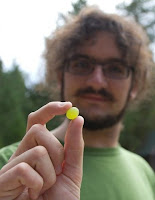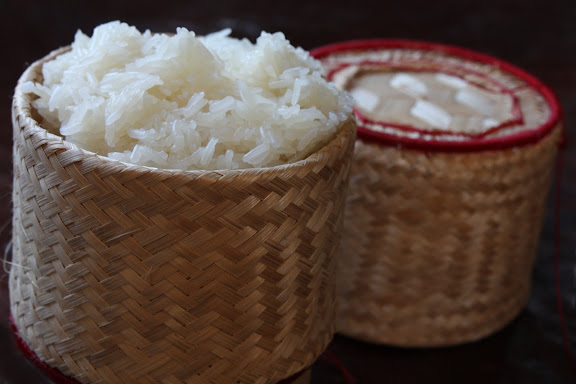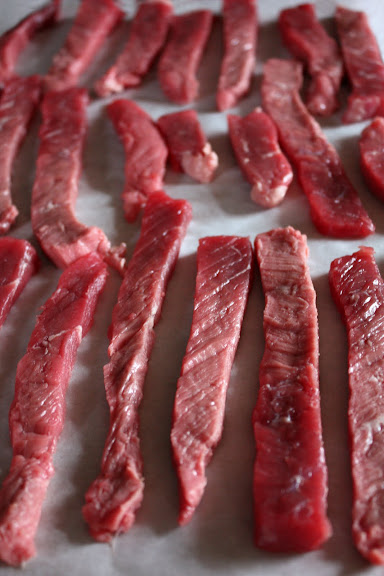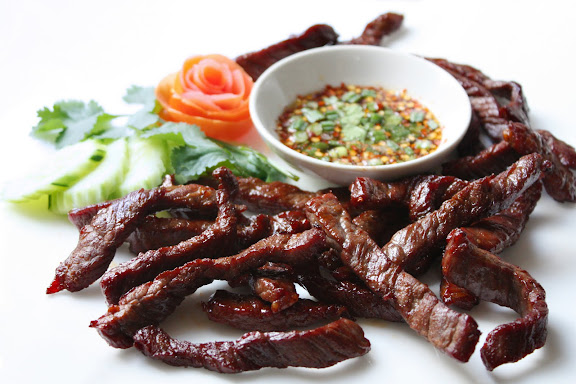
I am honored to introduce to you our reader-turned-contributor, Samuel Moehring. Sam has recently paid a visit to Lers Ros Thai restaurant and returned with a story to tell as well as a recipe to share. (Thank you, Sam!) The following article has been written by Sam; meet me back here in the recipe section. ~Leela
As a non-Thai, my experience with Thai food has focused around restaurants, solely—and I’ve come late in the game. Why do I tell you this, you may ask? I tell you this because I would like for my perspective to have a bit more context. When I write about Thai food, I really write about Thai restaurants. I don’t have deeply held memories of nam pla and palm sugar, certainly, but oh well. I guess I’m making those memories now, along the way.
The last thing I want to do is confirm the idea that white American guys only like red meat and starch, so when I’m out, I try to be the adventuresome eater. Am I trying to be deliberately iconoclastic? Am I trying to prove something to someone? Or myself? I don’t know.
It’s no chore, really, because I’ve found that some of my most exciting, eye-opening, or story-making (hey, it can’t all go perfectly!) culinary experiences have come of this, uh, mission, if you will. Despite all these wonderful experiences, I find that being the adventurous eater isn’t second nature all the time, and I sometimes find myself making a conscious effort not to embody the idea of the white American eater that I harbored.
So imagine my surprise when that idea got turned on its head in one fell swoop!
Now I have to rewind back a bit. Leela sent me to interview the owner of the venerable Lers Ros Thai in San Francisco. Going in there, I was expecting to write an article that helped Westerners understand (enlightened individual that I am … ha!) what they were missing about Thai food by ordering like I thought they did. Armed with a notepad and some preconceived notions, I drove over.
Khun Oh, the owner of Lers Ros, is an incredibly sweet woman. Not only was she a complete joy to talk to and interview, but she also managed to completely destroy the ideas I had coming into the interview. I started out by asking her what she thought was the biggest misconception held about Thai food. She said that oftentimes, Thai food is thought of as monotonously spicy, when in fact flavor balance is considered to be very important. I’ve heard people talk about this before, so I pressed on, eager to hear more of the folly that Khun Oh undoubtedly experienced on a daily basis. How, then, does this misconception affect American ordering habits? Turns out, it doesn’t … it’s all about experience, she says.
That sound you hear is mental strongholds under siege.
Khun Oh proceeded to paint a wonderful picture (late impressionist school) of her clientele, who, on the whole, are people who are wonderfully inquisitive about Thai food. They might have been to Thailand or are soon to visit, but they are looking to either recreate a memorable meal or prime themselves for a wonderful gastronomic experience on their upcoming trip. They often are asking about what they see the staff eating as well. Khun Oh actually used the word “community” to describe what goes on in her restaurant: people coming to talk to the waitresses or about Thailand, inquiring about travel advice … c’est si bon.
Misty-eyed idylls aside, Khun Oh proceeded to drop another bombshell on me when I asked her what she thought was the biggest barrier to Westerners enjoying real Thai food. The burden there, she says, lies with the owners of Thai restaurants! (What?) She says that many assume that Westerners won’t order this or that, so they throw it off of the menu.
Khun Oh doesn’t operate like that, though; she says she feels a responsibility to offer Thai food as it would be offered in Thailand. But wait! What about all my images of boorish eaters demanding chop suey at Lers Ros, refusing to touch anything fermented or with a face? My carefully constructed persona of the ugly American? Nowhere to be found. All that was left, then, was this glowing portrayal of the Lers Ros clientele — a curious group that wants what Thais really eat, not some vicariously constructed cuisine.
You know what? I was happy to be proved wrong.
 Sam is a chemistry student. At any given time, he may be found attached to an Erlenmeyer flask, a fork, a cast iron skillet, a pencil, or a bassoon. Not necessarily in that order. Often found speaking an idiolect loosely based on English, borrowing terms from his environment, like “Sharpless dihydroxylation,” “goatiness,” and “deceptive cadence.” Avid garlic consumer.
Sam is a chemistry student. At any given time, he may be found attached to an Erlenmeyer flask, a fork, a cast iron skillet, a pencil, or a bassoon. Not necessarily in that order. Often found speaking an idiolect loosely based on English, borrowing terms from his environment, like “Sharpless dihydroxylation,” “goatiness,” and “deceptive cadence.” Avid garlic consumer.
Asked why he has chosen fried sun-dried beef (listed on Lers Ros menu as “Neur Tod“) as the recipe to feature, Sam says, “I was curious about Lers Ros’ nuer tod because it seemed like an especially unique preparation for beef. Fried beef is hard to come by, especially beef that’s not been coated in batter. Plus, I’m easily lured by the promise of rice powder.” Good reasons.
Often called “Thai Fried Beef Jerky,” this sun-dried beef actually isn’t nearly as dry as most beef jerky products commonly found in the US. There are other beef dishes in the repertoire of Thai cuisine that more closely resemble western-style jerky; this isn’t one of them.
The beef is dehydrated, either in a very low oven or in direct sunlight, not to the point where it is completely dried and can be eaten without further cooking as is the case with western-style jerky, but only until it is dry to the touch. Much of the moisture is still retained inside the dehydrated “walls.”
Also, the method of seasoning used at Lers Ros Thai is different from what I am used to. That is to say, instead of marinating the beef strips prior to dehydration, they dehydrate the unseasoned beef strips first, then give them a quick (less than 30 seconds) toss with the seasoning before frying them. I was skeptical at first, but have come to see the wisdom of it. The wet seasoning that clings to the surface of the beef strips, once heated, forms a coating that is both delicious to eat and beautiful to look at due to the caramelization of the amino acids (both in the beef and the soy sauce) and sugar.

This is optional, but I highly recommend that you enjoy the fried sun-dried beef with warm sticky rice. These two are a match made in heaven. Fried sun-dried beef, Som Tam, and coconut rice also form a popular trio (ข้าวมันส้มตำกับเนื้อแดดเดียว) which you will find in many restaurants in Bangkok.
- 1 lb top round steak, cut into strips measuring approximately 4 inches long, ½ inch wide, and ¼ inch thick*
- 2 tablespoons fish sauce
- 1 tablespoon dark or light soy sauce
- 2 teaspoons sugar
- ½ teaspoon ground white (or black) pepper
- Vegetable oil for frying
- Heat the oven to 120°F and set a rack in the middle of it. Spread out the beef strips on a large cookie sheet and let them dry out in the oven for one hour. Turn the beef strips over and let them dry for another hour.
- You know the beef strips are ready when their surface is dry to the touch while the texture is still somewhat soft and elastic. When that happens, remove the beef strips from the oven or the drying basket and place them in a mixing bowl.
- Meanwhile, heat up some vegetable oil in a deep-fryer or a 8- to 12-inch frying pan with a raise edge on medium heat. You only need just enough vegetable oil to come up to about 2 inches from the bottom of the pan. Line a platter with a piece of paper towel and keep it nearby.
- Add the fish sauce, soy sauce, pepper, and sugar to the beef strip bowl and toss; make sure that all of the beef strips are evenly coated with the seasoning sauce.
- Test the oil by sticking a wooden skewer or chopstick into the oil, making sure the tip of the wooden skewer touches the bottom of the pan. If you see tiny bubbles rising from the point where the wooden skewer touches the pan, the oil is ready.
- Shake excess seasoning off of the beef strips and fry them in two batches. Be sure to stir the beef strips around to ensure even cooking. On medium heat, the beef only needs to be in the oil for less than a minute. You’ll see that the beef will brown up and develop a nice, glossy coating. When that happens, transfer them to the paper towel-lined platter.
- Serve the fried sun-dried beef with jaew dipping sauce.










23 Responses to Fried Sun-Dried Beef with Dried Chilli Dipping Sauce from Lers Ros Thai Restaurant, San Francisco: Neua Tod and Jaew (เนื้อแดดเดียวทอดและแจ่ว)